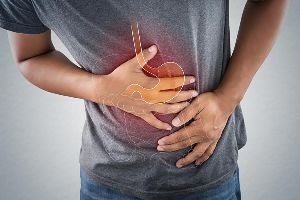
Acid reflux disease, also known as GERD (gastroesophageal reflux disease) is a chronic condition that causes the stomach’s contents to flow backwards into the esophagus (food pipe). The stomach acid that helps digest foods flows up into the esophagus, causing irritation and symptoms of GERD.
On the bottom part of the esophagus is a ring of muscle referred to as the lower esophageal sphincter (LES), which usually helps to keep the top of your stomach closed. It normally closes as soon as you swallow your food. Acid reflux occurs when the LES muscle doesn’t close all the way, or if it tends to open too often, causing the acid produced in the stomach to move up the esophagus.
In medical terms, GERD is the more serious and chronic form of acid reflux. However, you doctor might also use other names to refer to the condition:
- Acid regurgitation
- Acid indigestion
- Heartburn
- Acid reflux
- Reflux
Acid reflux disease can affect you daily life, with symptoms such as heartburn, which occurs as a burning chest discomfort. Fortunately, most people are able to get relief from it through home remedies, lifestyle changes, and medical treatment.
Facts About Acid Reflux Disease
- According to the American College of Gastroenterology, over 60 million Americans Experience heartburn at least once a month, with at least 15 million of them experiencing it as often as daily.
- The stomach acid that enters the esophagus can be dangerous and may lead to tissue damage.
- Reducing stress, maintaining a healthy weight, and quitting smoking can help to lower the risk of developing GERD.
- GERD is more common among the Western Countries, affecting about 20% to 30% of the population.
- GERD treatment may involve the use of antacids, protein pump inhibitors, lifestyle changes, and dietary modifications.
Causes and Risk Factors
Occasional acid reflux is quite common, as and in most cases occurs as a result of eating particular foods, lying down after eating, and overeating. Nonetheless, recurrent acid reflux, which is diagnosed as GERD, usually has other causes and risk factors, and can potentially have some serious complications. GERD affects people of all ages, and can sometimes occur for unknown reasons.
Some of the common risk factors for GERD include:
- Being obese or overweight
- Being pregnant – due to the higher pressure on the abdomen along with hormonal changes
- Consuming carbonated, caffeinated, and/or alcoholic beverages
- Smoking
- Eating large meals
- Eating foods such as citrus fruits, chocolate, tomato, peppermint, onion, fried, or spicy foods
- Taking certain medications like aspirin and ibuprofen or certain drugs for allergies, asthma, depression, high blood pressure, pain, sleep disorders, etc.
- Having a hiatal hernia – a condition where there’s an opening in the diaphragm that lets the top of the stomach move up the chest. This decreases the pressure inside the esophageal sphincter and increases the risk of GERD.
- Snacking just before bedtime

Symptoms
No matter the cause, acid reflux is often characterized by an uncomfortable burning feeling in your chest, that often radiates towards your neck. This is the feeling commonly referred to as heartburn. The heartburn tends to get worse if you bend over or lie down, and also after eating food.
You may also develop a bitter or sour taste at the back of your mouth if you have acid reflux. It might also make you regurgitate liquid or food from your stomach into your mouth. There are also cases where GERD can cause difficulty swallowing. In rarer cases, it might lead to breathing problems such as asthma or chronic cough.
Other signs and symptoms of acid reflux disease include black or bloody stool or bloody vomiting; bloating; hiccups that don’t let up; burping, nausea; unexplained weight loss; dry cough, wheezing, or chronic sore throat.
Complications
While GERD is usually not life threatening, it can potentially result into complications like:
- Esophageal ulcer: This occurs as an open sore in the esophagus, and is caused by tissue damage from the stomach acid. It could lead to bleeding, pain, and problems with swallowing.
- Esophageal stricture: this is the narrowing down of the esophagus that occurs when the acid reflux causes a build-up of scar tissue. It’s also referred to as peptic stricture, and it can cause problems with swallowing; though it might reduce the severity and frequency of heartburn.
- Barrett’s esophagus: this is a precancerous condition where the lining of the esophagus changes and closely resembles the lining of the intestines. While it may reduce heartburn symptoms, it raises the risk for developing esophageal cancer by a factor of 30.
- Esophageal cancer: this is a lethal form of cancer that current treatment can’t do much to slow down. It can be caused by years of untreated GERD.
Diagnosis
If you’re experiencing frequent symptoms of acid reflux should consult with their doctor, who might refer them to a gut medicine specialist referred to as a gastroenterologist for further investigation. The following are the most common tests that can be used to diagnose GERD:
- Esophageal pH and Impedance monitoring: This test monitors the amount of acid in the esophagus while the body is in different states, like sleeping or eating.
- Barium swallow: Also known as esophagram, a Barium swallow test checks for ulcers or the narrowing of the esophagus. It requires you to swallow a solution that helps structures who up on x-ray.
- Upper GI series: this is a kind of x-ray that highlights certain physical abnormalities that might lead to GERD.
- Upper gastrointestinal endoscope: This is a flexible tube that has a camera attached on one end, used to examine the esophagus. The doctor might take a small tissue sample at the same time in a biopsy.
- Bravo Wireless esophageal pH monitoring: With this test, a small temporary capsule is put into the esophagus. The capsule will then measure the acidity levels continuously for about 48 hours.
- Esophageal manometry: this evaluates muscle contractions in the esophagus during swallowing. It can also be used to measure the strength of the sphincter.
Treatment
In most cases, GERD will first be treated with medications before other lines of treatment are attempted. One of the most common pharmaceutical treatment options for acid reflux disease are proton pump inhibitors. They ideally work by reducing the amount of acid produced by the stomach.
Other pharmaceutical options include:
- Antacids: these counteract the acid produced in the stomach with alkaline substances. Side effects may include constipation and diarrhea.
- H2 Blockers: These help to decrease production of stomach acid
- Prokinetics: These work by helping the stomach empty faster than normal. Their side effects include nausea, diarrhea, and anxiety.
- Erythromycin: this is a form of antibiotic that helps to empty that stomach faster.
Another effective way of treating acid reflux disease is avoiding foods and drinks that trigger the symptoms and eating foods that reduce inflammation. Some of the steps you can take include:
- Quitting smoking
- Eating smaller meals throughout the day more frequently, and changing the kinds of food you eat
- Placing blocks under your bed to raise it by at least 4 inches to 6 inches
- Avoiding wearing tight clothes or belts
- Eating at least 2 to 3 hours before bedtime or lying down
- Taking steps to lose weight if you’re obese or overweight
- Trying to sleep on a chair for your daytime naps
- Avoiding medications that could be triggering symptoms of acid reflux
If medications and lifestyle changes don’t significantly improve the symptoms of acid reflux disease, your gastroenterologist may recommend surgery. Surgical treatments include:
- Endoscopic procedures: These include radiofrequency (uses heat to produce slight burns that tighten the sphincter muscle) and endoscopic sewing (uses stitches to tighten the sphincter muscle).
- Fundoplication: This involves sewing the top of the stomach around the esophagus, which adds pressure onto the lower end of the esophagus. It is generally effective at reducing acid reflux significantly.
Did you find this article helpful? Join us at HealingWell for support and information about GERD & Acid Reflux. Connect and share with others like you.


